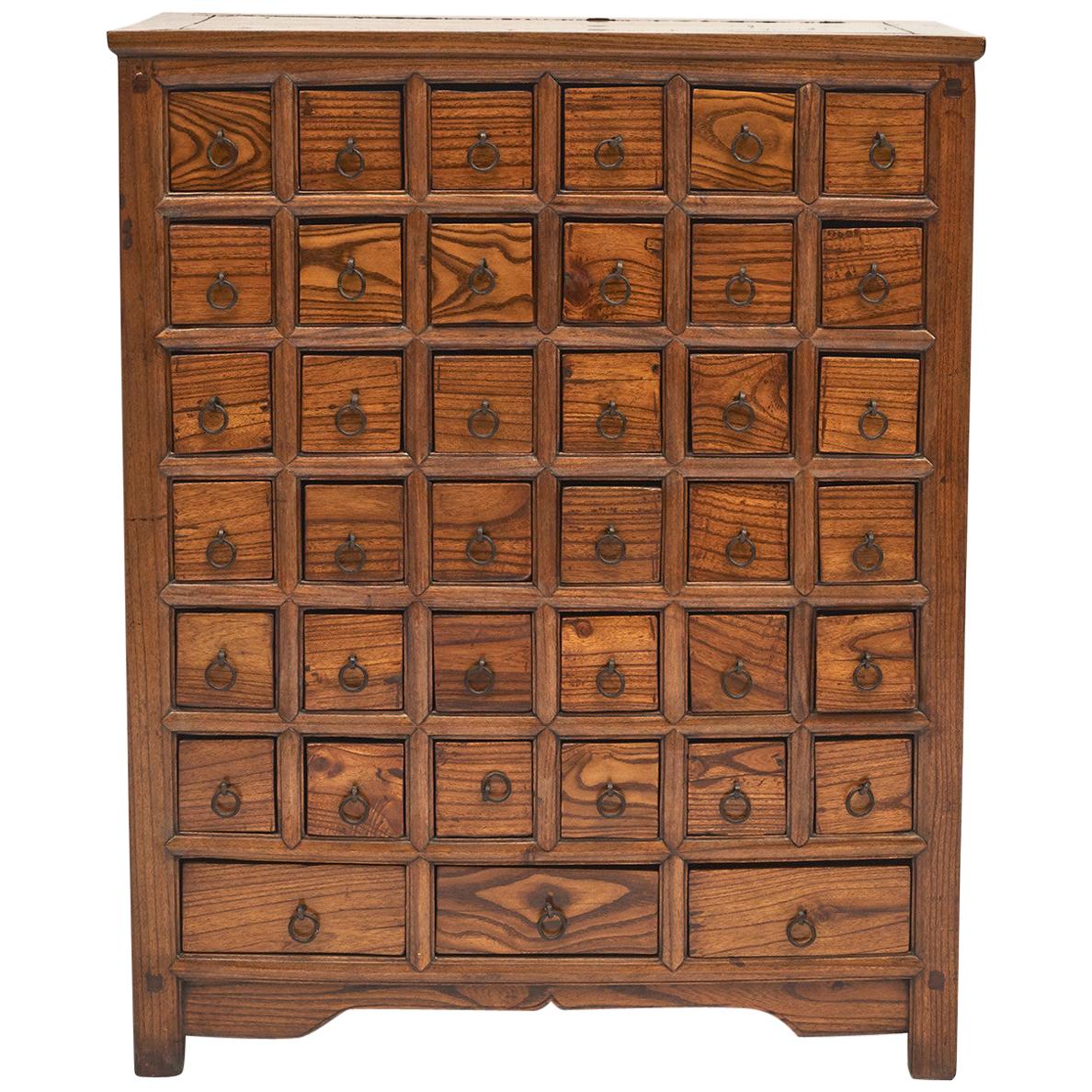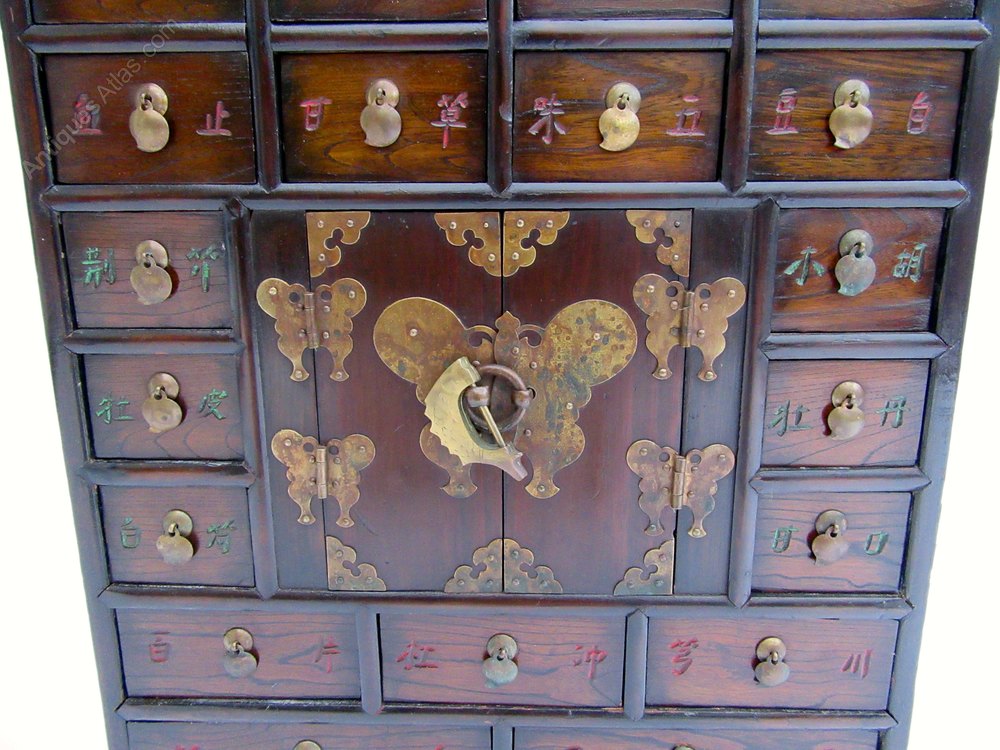Historical Significance of Antique Chinese Medicine Cabinets

Antique Chinese medicine cabinets, often referred to as “yao xiang” (藥箱), are more than just storage containers; they represent a rich history of traditional Chinese medicine (TCM) and the profound cultural values that have shaped their design and use.
Evolution of Chinese Medicine Cabinets
The evolution of Chinese medicine cabinets reflects the dynamic nature of TCM practices and the changing social landscape of ancient China.
- Early Forms (Pre-Han Dynasty): Prior to the Han Dynasty (206 BCE – 220 CE), medicine cabinets were simple, often made of wood or bamboo, and primarily used for storing basic herbal remedies and medicinal tools. These cabinets were often found in homes and were not as elaborate as later examples.
- Han Dynasty and Beyond: The Han Dynasty witnessed a significant expansion of TCM knowledge and practices. Medicine cabinets became more complex, incorporating multiple compartments for storing different types of herbs, powders, and liquids. They also began to incorporate decorative elements, reflecting the increasing importance of TCM in society.
- Ming and Qing Dynasties (1368-1912): During the Ming and Qing dynasties, Chinese medicine cabinets reached their peak of sophistication. They were often crafted from fine woods like rosewood and ebony, intricately carved with dragons, phoenixes, and other auspicious symbols. These cabinets were not just practical storage containers but also works of art, reflecting the status and wealth of their owners.
Construction and Design Features

Antique Chinese medicine cabinets, often referred to as “药柜” (yao gui), are testaments to both practicality and artistry. Their construction and design reflect a deep understanding of traditional Chinese medicine principles and a keen eye for aesthetic appeal.
Materials Used
The materials employed in constructing antique Chinese medicine cabinets were carefully chosen for their durability, resistance to moisture, and aesthetic qualities.
- Wood: The most common material was wood, particularly hardwoods like Chinese fir (Cunninghamia lanceolata), camphorwood (Cinnamomum camphora), and rosewood (Dalbergia spp.). These woods were known for their strength, durability, and pleasant aroma, which was believed to protect the medicinal herbs from pests and decay.
- Lacquer: After the wood was carefully prepared, it was often coated with layers of lacquer, a natural resin extracted from the lacquer tree (Toxicodendron vernicifluum). Lacquer provided a protective barrier against moisture, insects, and wear, and it also imparted a beautiful, glossy finish.
- Metal: Metal was used for hinges, locks, and other hardware. Iron, bronze, and brass were common choices, reflecting the craftsmanship of the time.
Design Elements
The design of antique Chinese medicine cabinets was not merely functional; it was also intended to be visually pleasing and symbolic.
- Shape and Size: The cabinets were typically rectangular or square, with varying heights and widths depending on the size of the practice and the number of herbs to be stored. They often featured a tiered structure, with shelves or drawers to organize the different medicinal ingredients.
- Ornamentation: The cabinets were often adorned with intricate carvings, paintings, and inscriptions. Common motifs included auspicious animals like dragons, phoenixes, and lions, which symbolized good luck, prosperity, and protection. Floral designs, geometric patterns, and calligraphic inscriptions were also prevalent.
- Color: The colors used in the cabinets were often symbolic. Red, for example, was associated with good fortune and prosperity, while black was associated with strength and stability.
Hardware
The hardware used in antique Chinese medicine cabinets was both practical and decorative.
- Locks: Locks were often made of metal and featured intricate designs, reflecting the skill of the blacksmiths of the time.
- Hinges: Hinges were typically made of iron or bronze, and they were designed to be durable and long-lasting.
- Drawers and Doors: Drawers and doors were often crafted with meticulous care, featuring dovetail joints and other traditional woodworking techniques.
Aesthetic Principles, Antique chinese medicine cabinet
The aesthetic principles reflected in the design of antique Chinese medicine cabinets were deeply rooted in traditional Chinese philosophy and art.
- Harmony: The design emphasized harmony between the cabinet’s form and function, reflecting the belief in the interconnectedness of all things.
- Balance: The use of symmetry, balance, and proportion created a sense of order and stability.
- Symbolism: The ornamentation and color schemes were laden with symbolism, conveying messages of good luck, health, and longevity.
Content and Organization

Antique Chinese medicine cabinets were meticulously designed to house a diverse array of medicinal ingredients and tools, reflecting the complexity and depth of traditional Chinese medicine practices. The organization of these cabinets reflects a deep understanding of the properties and uses of various herbs, minerals, and animal products, and the importance of maintaining their efficacy and purity.
Types of Medicinal Ingredients
The contents of an antique Chinese medicine cabinet encompass a wide range of substances, each carefully selected for its specific therapeutic properties.
- Herbal Remedies: The cornerstone of Chinese medicine, these include dried roots, leaves, flowers, seeds, and barks, meticulously collected and processed. Common examples include ginseng, licorice root, angelica, and chrysanthemum.
- Animal Products: Animal parts like antlers, bones, shells, and even dried insects are used in traditional remedies. For example, deer antler is believed to enhance vitality, while cicada sloughs are used for respiratory conditions.
- Minerals: A variety of minerals, including sulfur, cinnabar, and realgar, are incorporated into medicinal preparations. These minerals are often ground into powders or used in decoctions.
- Other Ingredients: The cabinets might also contain other materials like honey, beeswax, and even precious metals like gold and silver, which are believed to have medicinal properties.
Methods of Storage and Organization
Antique Chinese medicine cabinets are characterized by their intricate design, incorporating various compartments, drawers, and shelves to optimize storage and organization.
- Compartments and Drawers: Cabinets often have multiple compartments of varying sizes to accommodate different types of ingredients. Smaller compartments are used for delicate herbs or powders, while larger ones hold bulkier items like roots or animal parts.
- Shelves: Shelves are typically used to store containers of liquids or powders. These shelves may be adjustable to accommodate containers of different sizes.
- Inner Doors: Some cabinets have inner doors that can be locked, providing an extra layer of security for valuable or sensitive ingredients.
Labeling and Inscription of Containers
Labeling and inscription played a crucial role in the organization and identification of the medicinal ingredients within these cabinets.
The inscriptions often included the name of the herb or ingredient, its properties, and potential uses. Some inscriptions also included dosage guidelines or warnings.
- Calligraphy: Inscriptions were typically written in elegant calligraphy, reflecting the reverence and respect accorded to traditional Chinese medicine practices.
- Materials: Labels were often made of paper, silk, or even wood, and attached to containers using string or glue.
- Symbols: Some containers might also be marked with symbols or diagrams that visually represented the properties of the ingredients.
Hypothetical Layout of a Traditional Chinese Medicine Cabinet
Imagine a traditional Chinese medicine cabinet with multiple drawers and shelves, each dedicated to a specific category of ingredients.
- Top Shelf: The top shelf might hold containers of precious herbs, like ginseng or ganoderma, known for their high value and potent medicinal properties.
- Middle Shelves: These shelves could be used for storing herbs and minerals in various forms, such as powders, roots, and barks. Each shelf could be dedicated to a specific category of herbs, such as those for respiratory conditions, digestive issues, or circulation problems.
- Lower Drawers: The lower drawers might contain more bulky items like animal parts or large quantities of herbs. These drawers could also be used for storing tools and equipment, such as mortars and pestles, used for preparing medicinal mixtures.
Antique Chinese medicine cabinets, with their intricate carvings and lacquered surfaces, are a testament to the artistry and craftsmanship of a bygone era. While their purpose may have shifted from storing remedies to housing cherished keepsakes, the principles of maintaining a fresh and inviting space remain relevant.
Just as you might seek ways to how to keep shoe cabinet fresh , consider using natural air fresheners like lavender sachets or cedarwood blocks to infuse your antique cabinet with a pleasant aroma, reminiscent of the calming scents of traditional Chinese medicine.
An antique Chinese medicine cabinet, with its intricate carvings and lacquered finish, can be a beautiful addition to any home. While they may not hold herbs and remedies anymore, they can be repurposed to store other treasures. If you need more storage space in your kitchen, consider installing an under cabinet shelving rack to create extra space for your spices, oils, and other culinary essentials.
Then, your antique medicine cabinet can be a charming display for your favorite vintage cookbooks or family heirlooms.
